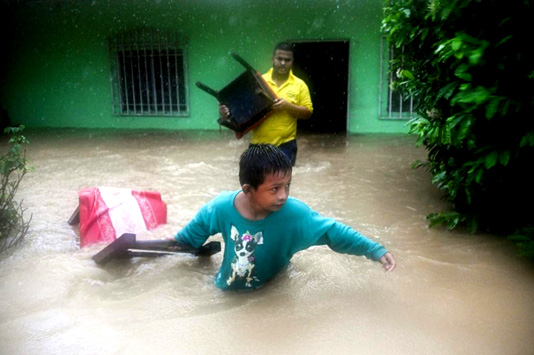
GUATEMALA CITY, Nov 6 (NNN-AGENCIES) — Scores of people, including 50 in Guatemala, have died as the remnants of Hurricane Eta unleashed
floods and triggered landslides on its deadly march across Central America.
Eta struck the Caribbean coast of northern Nicaragua as a Category 4
hurricane on Tuesday, tearing through impoverished coastal areas and sweeping away whole villages.
Two days later it exited Honduras as a tropical depression, although
weather forecasters warned it could again strengthen into a tropical storm as it heads towards Cuba.
The storm brought heavy rain that caused deadly flooding in Nicaragua,
Honduras, Guatemala, Costa Rica, El Salvador and Panama.
More than 50 people in Guatemala were killed in landslides unleashed by
Eta, President Alejandro Giammattei said Thursday.
“In the morning we had four dead, now the figure is over 50 dead,”
Giammattei told reporters late Thursday as he visited a flood-hit area of the
country’s battered Caribbean coast.
Giammattei said that one landslide buried 25 homes in an indigenous
community in the north of the country.
The president said it was impossible to reach the area because roads had
collapsed due to the heavy rain.
Around 10 people were killed in Huehuetenango in northwestern Guatemala, in another landslide.
The civil protection agency earlier reported that five people died in
separate landslides, including two children aged 11 and two, whose fragile
family dwelling was swept away.
The Guatemala deaths brought the overall toll from Eta to more than 60, as
earlier officials said 18 people had died across the region.
Panama also felt the force of Eta’s wrath, as landslides buried two homes
in Chiriqui province on the Costa Rican border, killing five people, the
National Protection System said. Among the victims were three children.
Landslides also claimed the lives of two children in Honduras, emergency
services reported.
In Costa Rica, a 71-year-old American and his Costa Rican wife died when a
landslide buried their home in the southern canton of Coto Brus, on the
border with Panama. Emergency workers recovered their bodies.
In Honduras, President Juan Orlando Hernandez ordered the army to mobilize helicopters and boats to evacuate flooded areas amid reports of “intense and catastrophic” rain hitting the capital Tegucigalpa and its population of one million.
Landslides swept away roads and bridges around the country.
San Pedro Sula, the country’s second-largest city, as well as the
industrial valley in which it sits, were badly hit by floodwaters after the
Ulua and Chamelecon rivers overflowed.
Across northern Honduras scores of people were forced to flee to the roofs
of their homes as floodwaters rose, relief agencies said.
Overall more than 330,000 people had been affected by the floods in
Honduras, disaster agency COPECO said, with 3,000 already evacuated from the path of the storm on Wednesday.
Two children, an eight-year-old and a toddler of 11 months, died when a
mudslide swept their home away in the northwestern department of Santa
Barbara, police said.
Two other children were killed in similar circumstances in the country’s
south, authorities reported Wednesday.
In Morales, northeastern Guatemala, flood victims were being sheltered in a sports stadium.
“My whole house is full of water. I’ve lost everything. My chickens and my
little pig were swept away by the river,” said Eliseo Gonzales, a retired
driver who found refuge there.
In El Salvador, officials reported 26 landslides blocking roads, and said
nearly 2,000 people had been evacuated amid heavy rains and flooding.
Even as Eta eased to a tropical depression, the US National Hurricane
Center continued to warn of “life-threatening flash flooding” over portions
of Central America.
Eta slammed ashore at the northern Nicaraguan coastal town of Bilwi — also known as Puerto Cabezas — on Tuesday packing winds of 130 miles (210 kilometers) per hour that knocked over walls, uprooted trees, downed power lines and tore roofs off dwellings.
As the surface layer of oceans warms due to climate change, hurricanes are
becoming more powerful and carrying more water, posing an increasing threat to the world’s coastal communities, scientists say.
Storm surges amplified by rising seas can be especially devastating. — NNN-AGENCIES




